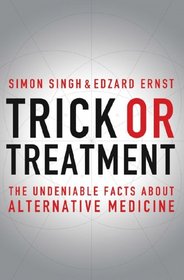A very good explanation of how evidence based medicine can evaluate any treatment, medical or alternative. This book is written very clearly and simply and the authors take an in depth look at acupuncture, homeopathy, chiropractic and herbal therapies. They briefly address many other alternative therapies. They write from a British perspective.
Trick or Treatment is a bluntly objective look at alternative medicine. It is written for the consumer, consequently the first chapter is devoted to the scientific method in order to introduce the layman to how data potential treatments should be evaluated. the authors challenge the reader to keep an open mind and read the rest of the book with the scientific method in mind.
Acupuncture, herbal remedies, homeopathy, and chiropractic get their own chapters. In fairness, the authors do point out what treatments demonstrate efficacy, though they also point out potential side effects and disadvantages (particularly cost). Since it is not possible to give all the alternative treatments offered today a full chapter, a reference guide at the end is offered. The guide is very helpful in that it offers a brief history of the treatment, a summary of what (if any) scientific investigation has been conducted, and a decision about whether the treatment is worthwhile.
Although Trick or Treatment's overall message is that alternative therapies are rarely effective and in the best cases only comparable to conventional medicine, the mountain of evidence presented and one of the author's background in homeopathy makes the conclusions laid out in the book difficult to ignore. This book is highly recommended for the conscientious consumer and patient.
Acupuncture, herbal remedies, homeopathy, and chiropractic get their own chapters. In fairness, the authors do point out what treatments demonstrate efficacy, though they also point out potential side effects and disadvantages (particularly cost). Since it is not possible to give all the alternative treatments offered today a full chapter, a reference guide at the end is offered. The guide is very helpful in that it offers a brief history of the treatment, a summary of what (if any) scientific investigation has been conducted, and a decision about whether the treatment is worthwhile.
Although Trick or Treatment's overall message is that alternative therapies are rarely effective and in the best cases only comparable to conventional medicine, the mountain of evidence presented and one of the author's background in homeopathy makes the conclusions laid out in the book difficult to ignore. This book is highly recommended for the conscientious consumer and patient.




